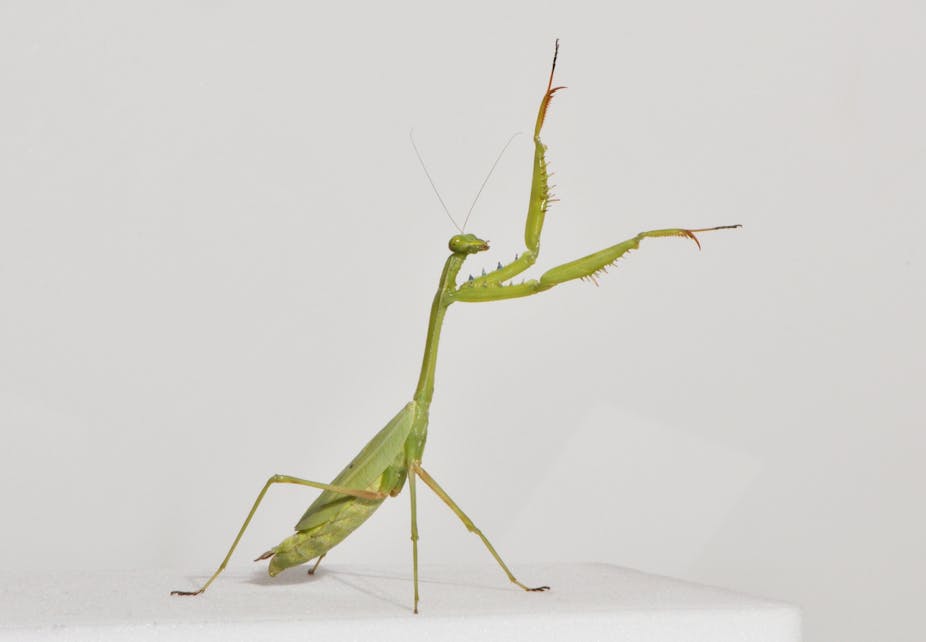Praying mantises are notorious – both for their deadly striking behaviour that they use to capture prey and for the gruesome female habit of eating their partners after mating. But their speed, agility and accuracy at jumping has not been widely recognised – until now. New research in Current Biology shows that the mantis jump is something rather special.
Juvenile mantises have no wings, as these appear only in adults. In their natural habitat among the stems of plants or the branches of bushes and trees, juveniles have little option but to jump if they need to move to another branch. They reach their target with great accuracy and with great speed – less than a tenth of a second, or in the blink of an eye. How do they achieve this remarkable feat?
To answer this question we took high speed videos (1,000 frames per second, or 30 times faster than normal videos) of mantis jumps made from a horizontal platform toward a target of a vertical, black rod, so that we could slow down time and reveal what they were doing and how they were doing it.
Beady-eyed decisions for complex spins
We found that the mantises first scanned the target from their horizontal platform by making side to side movements of their head – seemingly eyeing up the vertical target to estimate distance. If the target was close they would reach out with their long front legs (which they use for capturing prey) and simply grasp it. If the target was deemed too far away it was simply ignored. At distances in between, they would jump toward the target and sail through the air to reach it with remarkable accuracy.
Before take-off the mantises curl their abdomen to adjust their centre of mass. This ensures that the propulsive forces generated by the middle and hind legs act just sufficiently away from the centre of mass to impart a spin on the body as it leaves the platform.
Once in the air the mantises precisely rotate three body parts – the front legs, the hind legs, and the abdomen – in different directions and in different combinations, all the time exchanging momentum between them and keeping the spin of the whole body at the correct rate to successfully reach and land on the target.
We can show that these mechanical mechanisms are responsible for the precision jump of the mantises in two ways. First, by building a model (that is, a mathematical model – not an artificial mantis) to simulate a natural jump, we asked what happens when there is no rotation of one body part – say the front legs. We found that the body then rotates about twice as fast and ends up misaligned to the target.
Second, by experimental manipulation we could interfere with the rotation of a body part during a natural jump. For example, we glued the abdomen so that it could not be curled as much, with the result that the mantises took off with less spin and once airborne headed straight for the target and crashed head first into it.
We conclude that praying mantises are using the complex interplay between the counter-rotation of three body parts to exchange momentum and thus to orient their body to land on a target. Amazingly, they are doing all this in the blink of a human eye.

The controlled trajectory of mantis jumps contrasts with many insects which spin in the air after they have jumped and as a consequence frequently crash land. The major concern of these other insects, however, is to move as quickly as possible away from a predator or other source of harm. For these insects the speed of escape is paramount and the importance of stability is downplayed. Indeed, this uncontrolled high-speed spinning may be an advantage in that it makes the trajectory of a jump difficult for a predator to predict, and thus improves the chances of survival.
Outside the insect lab, learning from the way mantises solve the problem of stability may aid the design of small jumping robots, where controlling spin continues to be a challenging problem.

